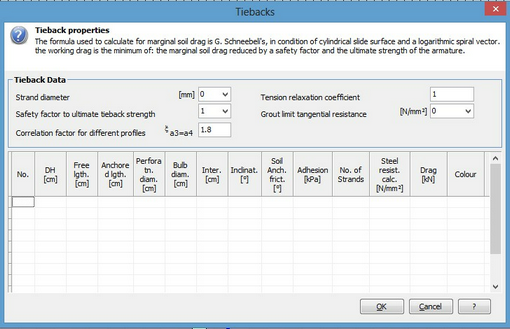|
Tiebacks |

|

|
A tieback is considered by the program as a force of the same magnitude as the drag, applied to the wall. This force is taken into consideration in the calculation of global stability whenever any potential slide surface crosses the line of the tieback.

N°
Ordinal tieback no.
DH [cm]
Distance of tieback from wall stem head.
Li [cm]
Length of drag rod/cable of tieback.
La [cm]
Length of anchor part of tieback.
Df [cm]
Perforation diameter.
Db [cm]
Bulb diameter.
Inter. [cm]
Longitudinal spacing.
Incl. [°]
Angle to horizontal.
Soil-Tieback friction [°]
Soil/Tieback angle of friction.
Adhesion
Tieback/Soil adhesion.
No. of Strands
No. of strands in tieback cable.
Tieback drag
User choice for drag value for tieback that, when entered, overrules that calculated (and shown here) by the program.
Colour
Select colour that should denote the tieback.
Suggested path to applying tiebacks to wall:
| 1. | Calculate wall without tiebacks. |
| 2. | Enter tieback geometry: as data is entered the program automatically calculates the tieback's drag. The user can override the calculated value by entering the preferred one. |
| 3. | Repeat wall calculation and check the foundation stress diagram. It is desirable that this diagram result roughly rectangular or at least with the major side on the uphill side. Further slide safety and overturning safety should verify. |
| 4. | If the foundation stress diagram does not satisfy the above requirements, the drag should be reduced or increased as required. |
| 5. | If limit load verification fails, piles should be introduced. |
| 6. | The tieback rod(cable) length should be such as to place the anchor bulb outside the rupture zone identified by the program after tieback insertion. |
© GeoStru Software